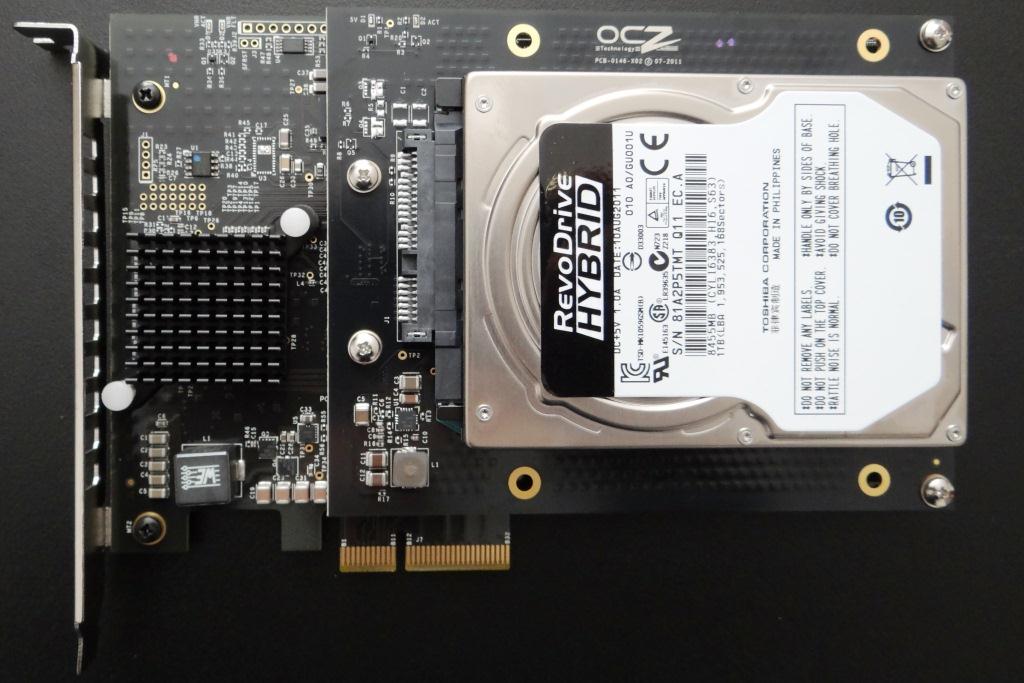DUAL DRIVES SYSTEMS, HYBRID AND DISK CACHING
It wouldn’t be fair to complete this article without mention of some of the other emerging technologies and considerations that could assist the consumer. As much of a benefit as hard drive capacity is, it is simply a killer in performance. As incredible as SSD performance is, higher capacity necessitates a higher price. The key to this will definitely be the combination of both at a price the consumer is willing to pay.
For the desktop, OCZ tackled that with the RevoDrive Hybrid PCIe SSD which gives us the performance of the Revo 3 SSD coupled with the 1TB capacity of the hard drive. This is a great solution for desktop users and utilizes NVELO Dataplex disk caching software to accomplish this.
Disk caching is simply the retention of ‘hot’ programs and data within the SSD cache while those files seldom used remain on the hard drive. The advantage here is the fact that the frequently used data is learned, remembered and remains in the cache even after the computer has been shut down. This is the beauty behind 17 second start ups and faster performance with a cached drive in comparison to those minute plus start ups we see in a typicle system.
NOTEBOOKS AND ULTRABOOKS
While disk caching is a huge benefit to desktop systems, it has not yet reached the notebook crowd and this may be due, in part, to the lack of portable systems that allow for dual hard drives or a mSATA SSD and a hard drive. In our testing of the NVELO Dataplex software, we used a Lenovo X220 which contains both an mSATA SSD and hard drive. During our testing, we switched off seven different mSATA SSDs and tested their performance as a standalone SSD as well as a caching SSD for the NVELO software.
Lets take a look at the results of each and every one of the mSATA drives we tested. The darker bars represent read and write speeds of just the mSATA SSD while the lighter bars represent the performance of the hard drive while the mSATA SSDs were using NVELO Dataplex to cache.
For the desktop, disk caching certainly improves on our former recommendation of purchasing a moderate size SSD for a boot drive and hard drive for storage of larger media to include video, music and pictures. For the notebook however, we have to look at options available to meet our needs. This might mean a higher priced SSD, or purchase of a system with dual drive bays or a mSATA and HDD bay, or, we have seen many swap out their DVD drive for a hard drive and adapter in the past.
One thing appears certain though. The future looks good!
 The SSD Review The Worlds Dedicated SSD Education and Review Resource |
The SSD Review The Worlds Dedicated SSD Education and Review Resource | 


We L-U-V all the fine photos, Les.
KEEP UP THE GOOD WORK!
/s/ MRFS
The writing here is terrible. You should hire an editor.
Just how massive is your Mastiff.
An effective warning about your security system to potential evil-doers.
Great picture… I did a double-take.
He is 220 lbs of security! Tx for the comment!
Great article! very benficial, helped me understand the SSD arena and how to make an informed decision at purchase time. keep up the good work.
Thank you Mark!
You mention on page 3 “The mSATA SSD measures about 50mm long x 49mm wide x 4.85mm thick, or 1/3 the size of a business card”. Measurements are 50.8mm x 29.85mm x 4.85mm. Not 49mm.
Doooh Tx! Fixed.
Articles like these are one of the reasons I hold your site in such high regard. You do not cater only to the high-level enthusiast crowd, but instead work hard to ensure that you maintain as technologically-diverse an audience as possible. While many have tried to do this before, it has almost always inevitably resulted in failure, likely as a result of many websites “talking to” their more mainstream consumers as if they are stupid. You guys have managed to avoid this, and as such, I recommend this site to everyone who is considering purchasing a new storage solution, from friends who can barely manage to work an iPhone to others who share the same level of enthusiasm as myself when it comes to building their own PC.
You guys rock!
Thank you Nick. Receiving feedback as such is more valuable than you can imagine and kinda puts a bit of adrenaline into our work ethic!
GC AND TRIM IN SSDS EXPLAINED link does not work
Fixed and thank you very much! Sometimes things like this slip through as we update!
A few words to tell you how much I have enjoyed reading your articles. I am preparing for my leap to an SSD. My lack of knowledge has prevented me until now. You have a skill of explaining things that has helped me greatly. Thanks.
Thanks Chuck and good luck. Don’t be afraid to jump into our Forums if you have any need for immediate assistance whatsoever…
Thanks for your article. I’m about to purchase the Sonnett Tempo Pro Plus.
https://www.youtube.com/watch?v=KMQaDRcr4AU
Do you have an opinion on this one. I like the idea of utilizing my current 250gb Samsung SSD which has been plodding along in the bay drive. I have a Mac Pro, Early 2008 which has the second PCI slot only being used by a 3.0 USB that I put in last year. I need processing power for Final Cut multi-cam editing. I can get by with this cheaper than the OWC 480gb version. Of course no 3 year warranty. The Sonnett looks cool, but no reviews on B&H. What would you do?
This one badly needs an update Les 🙂
Yes I know where you are coming from… Thanks ahead.
Great job!